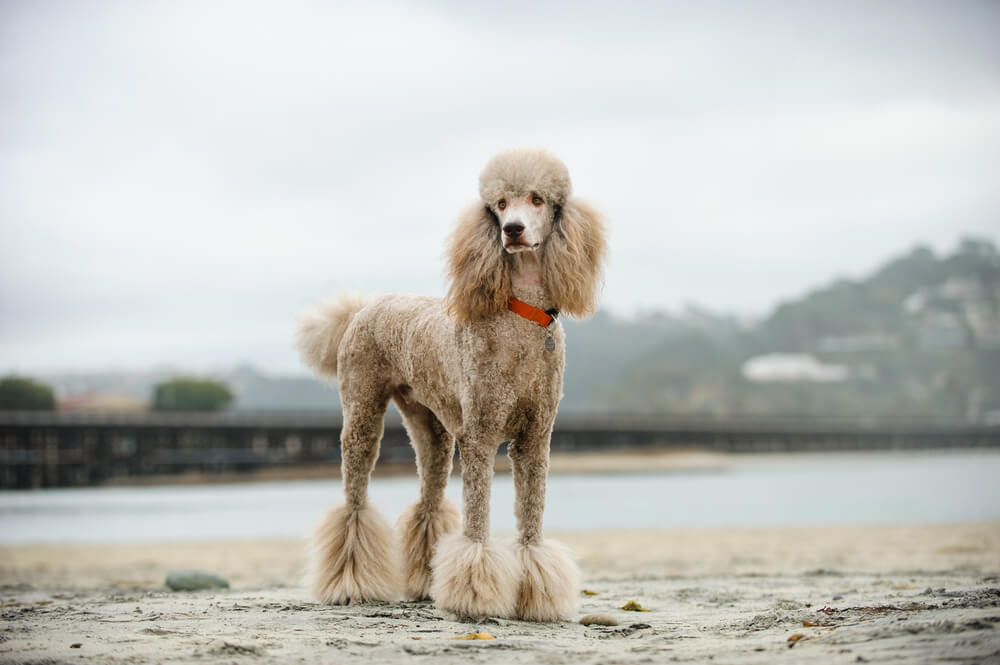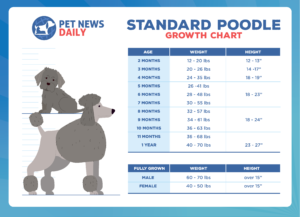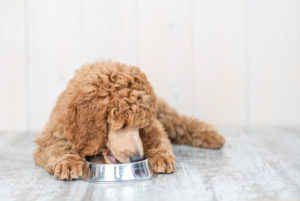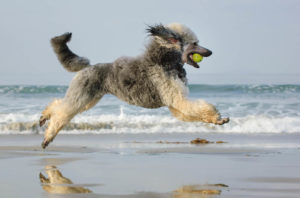As you get to know your new puppy, you may be wondering how big he or she might get. We consulted with our veterinarian, Dr. Jennifer Coates, who reviewed and approved data about puppy weights and sizes, which we then used to create a convenient puppy growth chart. You can use this as a reference to see how your puppy compares to the average.
The chart shows you a Standard Poodle’s monthly average weight range during the growing phase. You can also refer to the puppy weight calculator to get an idea of how big your puppy is likely to get.
In This Article
Standard Poodle Growth Chart
- 1 year: 40-70 pounds, 23-27”
- Fully grown males: 60-70 pounds, over 15 inches
- Fully grown females: 40-50 pounds, over 15 inches
Text Transcript of the Standard Poodle Growth Chart
| Standard Poodle – Age | Weight | Height |
|---|---|---|
| 2 months 3 months 4 months 5 months 6 months 7 months 8 months 9 months 10 months 11 months 1 year |
11-20 pounds 20-26 pounds 24-35 pounds 26-41 pounds 28-48 pounds 30-55 pounds 32-57 pounds 34-61 pounds 36-63 pounds 38-68 pounds 40-70 pounds |
12-13” 14-17 18-19 18-23” 18-24” 23-27” |
About Standard Poodles
The poodle is one of the most recognizable breeds of dogs available. It comes in three different sizes: Standard, Miniature, and Toy. They all have similar characteristics, with some key differences.
In this article, we’ll focus on the Standard Poodle.
One of the reasons people love the poodle is its coat. Considered non-allergenic or hypoallergenic, it releases fewer allergens into the air than most other dogs’ coats do. Poodles rarely shed, making them the perfect choice for people who typically suffer from allergies to dog dander.
Poodles can also be a lot of fun to groom. Their curly hair can be trimmed and poofed into all sorts of fancy clips, making this breed the true fashion icon of dogs.
Despite this characteristic, poodles are eager, athletic, and “wickedly smart” according to the American Kennel Club (AKC), and can be trained “with great success.”1
The breed originated in Germany, where the word “pudelin” refers to splashing in the water. Indeed, the Standard Poodle began as a retrieving water dog more than 400 years ago. Its coat protected it against the elements and give it a free range of movement in the water.
Today, the poodle is a highly versatile breed that can be trained to do just about anything. Athletic, agile, smart, and eager to please their owners, they make natural entertainers, retrievers, good hunters, helpful therapy dogs, and even superb watchdogs.
Without enough activity, though, they may get bored, so daily exercise and mental stimulation are critical for their overall health and good behavior.
What Are the Growth Stages of a Standard Poodle?
A Standard Poodle, when first born, will weigh only a few ounces to a pound and be less than 10 inches high at the shoulder. The first few weeks will be a time of rapid growth and development, when their eyes and ears will open and they’ll start interacting with people and their littermates.
1 to 2 Months Old
By one month old, your Standard Poodle puppy will start exploring her new world. She’ll be putting on weight, and will range between five and nine pounds. Her baby teeth will come in around this time, and she’ll be able to start eating dog food.
2-3 Months Old
By two months old, she’ll be ready to be weaned from her mother and go home with you. It’s good to start housetraining at this time, and to get her vaccinations. She should eat between three to four meals a day of high-quality puppy food, and weigh between 10 and 20 pounds. (Males are usually bigger than females.)
3-4 Months Old
At three months old, your puppy will start to show an independent streak. Housetraining should be well underway, along with leash training. Don’t be surprised if you notice her shedding a little bit. This is when her wispy puppy hairs will be replaced with her more adult, thicker hair. The process is gradual, though, so you don’t have to worry about excessive shedding.
4-8 Months Old
Between four and eight months, your poodle’s growth rate will start to slow down a little bit. She will be leaving the puppy stage and entering the adolescent stage. This is when she’s more likely to want to explore, test her limits, and even get herself into trouble! Consistent obedience training with positive enforcement will be key during this time to help her grow into an enjoyable companion.
This is also when your puppy’s adult teeth will start coming in, so be sure she has plenty of chew toys to help alleviate the pain and satisfy her need to chew. By five months your Standard Poodle will be large—males will weigh between 32 and 40 pounds and females between 26 and 30 pounds, so she will likely be more of a handful. Housetraining should be complete by now, but it’s important to continue with obedience training and socialization.
By six months, your dog will be larger than small- and medium-sized dogs of other breeds. She’ll still be playful but may be clumsy at times as she learns to manage her long limbs. She’ll need daily walks to keep her energy in check. At the eight-month mark, you can expect her to look more like an adult dog and to be near her final adult size, though she’ll continue to fill out until she reaches two years old.
1 to 2 Years Old
At the one-year age point, she should be acting a little calmer and more mature, though poodles take up to two years to reach full growth and maturity.
Best Nutrition for a Standard Poodle
At all stages of growth, it’s important to feed your Standard Poodle a high-quality, large-breed dog food with real meat (beef, chicken, pork, fish, lamb) as the first ingredient.
Avoid those foods with meat by-products, chemical preservatives, and a lot of artificial dyes and flavors.
Choose instead those with fewer ingredients that you can pronounce and understand and that are nutritionally balanced for a large dog. A food “for all sizes” will not provide your puppy with the right nutrients for optimal growth.
Until your puppy reaches about one year of age, it’s best to split his meals up to three meals per day. This is easier on his digestive system and helps keep his blood sugar in balance.
When your dog reaches the one-year mark, you can back off to twice a day and choose an adult (rather than a puppy) food. Follow the suggested feeding guidelines, and check with your veterinarian if you notice any issues.
Poodles do well on dry food, but you can also combine wet and dry if you like to add some extra taste and moisture. Avoid an all-wet-food diet, however, as this isn’t good for your dog’s teeth and gums.
Dry kibble is also easier on the stomach and intestines. An all-wet-food diet can lead to runny stools.
Snacks and treats can be an important part of your dog’s diet and training program. Just be careful what you feed your four-legged pal, as the wrong foods can mess up his stomach and lead to overweight.
Choose baked or dry dog treats for snacks, and save the moist or chewy ones for training rewards.
Don’t forget water! Make sure your dog’s water bowl is always full and frequently changed, at least once every day. A dog water fountain can help keep the water fresh-tasting while filtering out bacteria.
As your dog grows, keep an eye on his weight. Overweight and obesity in puppies can lead to health problems later in life. A good rule of thumb is to feed puppy-specific foods until your pup reaches full growth, which is usually around 12 months of age.
Due to their full coats, Poodles can put on excess weight without you realizing it. Check by examining the ribs and waist. You should be able to easily feel but not see the ribs and note a well-proportioned waist when looking at your dog from the top.
The World Small Animal Veterinary Association (WSAVA) offers some helpful illustrations of proper body condition.
How Big Will My Standard Poodle Get?
As long as your Standard Poodle is still under a year old, she’s still growing. After a year, she may continue to gain a little weight as she fills out, but her height will stay about the same.
To estimate about how big your Poodle will get, you can try a few things. Start with the dog’s parents if you can. If you bought the dog from a breeder, ask for information about the mother and father and their weight and height, as your dog will likely grow to a similar size.
Your puppy’s sex matters too. As with many other animals, males are typically larger than females.2 Whereas females can weigh between 40-50 pounds, a male can weigh between 60-70 pounds.
Another way to estimate your puppy’s final growth weight is to use this simple formula:3
(Current weight/Age in weeks) x 52.
For example, if your pup is 25 pounds at 16 weeks of age, the formula would look like this:
- (25/16) = 1.57 (rounded up)
- 1.57 x 52 = 82 (rounded up)
The best time to check your Standard Poodle with this formula is when they reach about 16 weeks of age.
Try checking your puppy’s paws as well. If they look oversized compared to the pup’s legs and body, you can imagine the final growth based on the size of those paws.
When Do Standard Poodles Stop Growing?
Poodles are considered fully growth adults at two years old. This is when they have finished filling out and also when they will show signs of emotional maturity.
Before that, though, by the age of one year, your dog will have reached his final height or very close to it. After that, the growth will be focused on filling out muscle and cementing final bone formation.
Things That Affect Growth
Like most purebred dogs, Standard Poodle are vulnerable to a few health issues.4 These include:
- Hip dysplasia
- Epilepsy
- Addison’s disease (hormonal disease)
- Heart disease
- Bloat
- Hypothyroidism
- Eye diseases
- Skin problems
These can affect growth if they occur early on, but most don’t appear until later in your dog’s life. More common factors affecting growth include genetics, nutrition, and physical activity. Genetics establish how fast your puppy will grow and how big he will get.
Nutrition is a key element of proper growth for your Poodle puppy. Underfeeding can result in malnutrition, while overfeeding can strain muscles and joints, leading to skeletal problems later in life. Regularly check your dog’s weight to be sure you’re where you need to be.
Physical activity is key for muscle and bone development and for maintaining a healthy weight. Just be careful not to overexercise your young puppy on hard surfaces like pavement and asphalt. This can negatively affect bone growth. Wait until he’s at least a year old before taking him on long runs on the road.
Poodles are known for being enthusiastic eaters and often gulp down their food very quickly. This can lead to issues including bloat which can be serious. It also causes excess gas, vomiting, and gagging.
To slow mealtimes down, create a peaceful dining area where your Poodle will not be disturbed. Have pets eat separately (if you have more than one), provide more frequent and smaller meals, and incorporate a few snacks to help keep your dog satisfied between meals.
You can also purchase a “slow-feed” bowl that encourages slower eating by forcing a dog to eat around small obstacles. These work well at preventing your Poodle from gulping his food.
Infections with intestinal parasites like hookworms can also affect your puppy’s growth. If you notice that he doesn’t seem to be gaining weight like he should, check with your vet about a potential de-worming treatment.
If you don’t want to have puppies, spaying or neutering your dog will be necessary. It’s important not to do it too soon, however, or you may negatively affect bone and joint growth. Talk to your veterinarian about when the best time may be for your dog.
Puppy Weight Calculator
PUPPY WEIGHT CALCULATOR
Frequently Asked Questions
When your male Standard Poodle is fully grown, he should weigh between 60-70 pounds and stand between 23-27 inches high at the shoulder. Your female will likely be between 40-50 pounds and stand about the same height, though the AKC says anything over 15 inches is fine.
At six months of age, your Standard Poodle should weigh between 28 and 48 pounds and stand between 18-23 inches at the shoulder.
When your puppy reaches 8 months of age, he’ll weigh about 40-48 pounds. A female will weigh about 28-35 pounds.
At the two-month mark, your Standard Poodle puppy will weigh between 10-20 pounds.
The Standard Poodle was bred to work which means that they’re likely to have boundless energy that has to be focused. Even with their great temperament, they need a job to do. Without one, they can become extra exuberant or even hyper.
As your dog matures, he’s likely to calm down quite a bit. This begins around one year of age and continues in a gradual process until he’s two to three years old. To help your dog calm down, be sure to give him daily exercise and a variety of things to do. Safe play sessions with other dogs, time to swim, daily walks, puzzle toys, games of fetch, obstacle-course training, and more can all help keep your Poodle occupied and focused so he’s calmer in general.
In our guide to the best collars for Poodles our veterinary advisor selected the Fida Heavy Duty Dog Collar.
In our guide to the best dog clippers for Poodles our veterinary advisor selected the Wahl Professional Animal Chromado Lithium Dog Clipper Kit.
Additional Resources
If you’re looking for more information about dog growth in general, we’ve created a puppy weight calculator, an in-depth guide to how heavy your dog should be, and a series of growth charts for different breeds (and dogs and mixed breeds in general):
- Great Dane Growth Chart
- Goldendoodle Growth Chart
- Chihuahua Growth Chart
- Golden Retriever Growth Chart
- Labrador Growth Chart
- Dog Growth Chart
- Mixed Breed Growth Chart
- Rottweiler Growth Chart
- Pit Bull Growth Chart
- Australian Shepherd Growth Chart
- French Bulldog Growth Chart
- Great Pyrenees Growth Chart
- Standard Poodle Growth Chart
- Bernedoodle Growth Chart
- Husky Growth Chart
Article Sources
Pet News Daily uses only high-quality sources, including peer-reviewed studies, to support the facts within our articles. Read our editorial process to learn more about how we fact-check and keep our content accurate, reliable, and trustworthy.
- Poodle dog breed information. (n.d.). American Kennel Club. https://www.akc.org/dog-breeds/poodle-standard/
- Staff, A. (2017, May 11). Breed weight chart – American Kennel Club. American Kennel Club. https://www.akc.org/expert-advice/nutrition/breed-weight-chart/
- Puppy growth: What you need to know. (n.d.). Bond Vet. https://bondvet.com/b/puppy-growth
- Health concerns. (2020, May 29). The Poodle Club of America. https://poodleclubofamerica.org/health-concerns/




